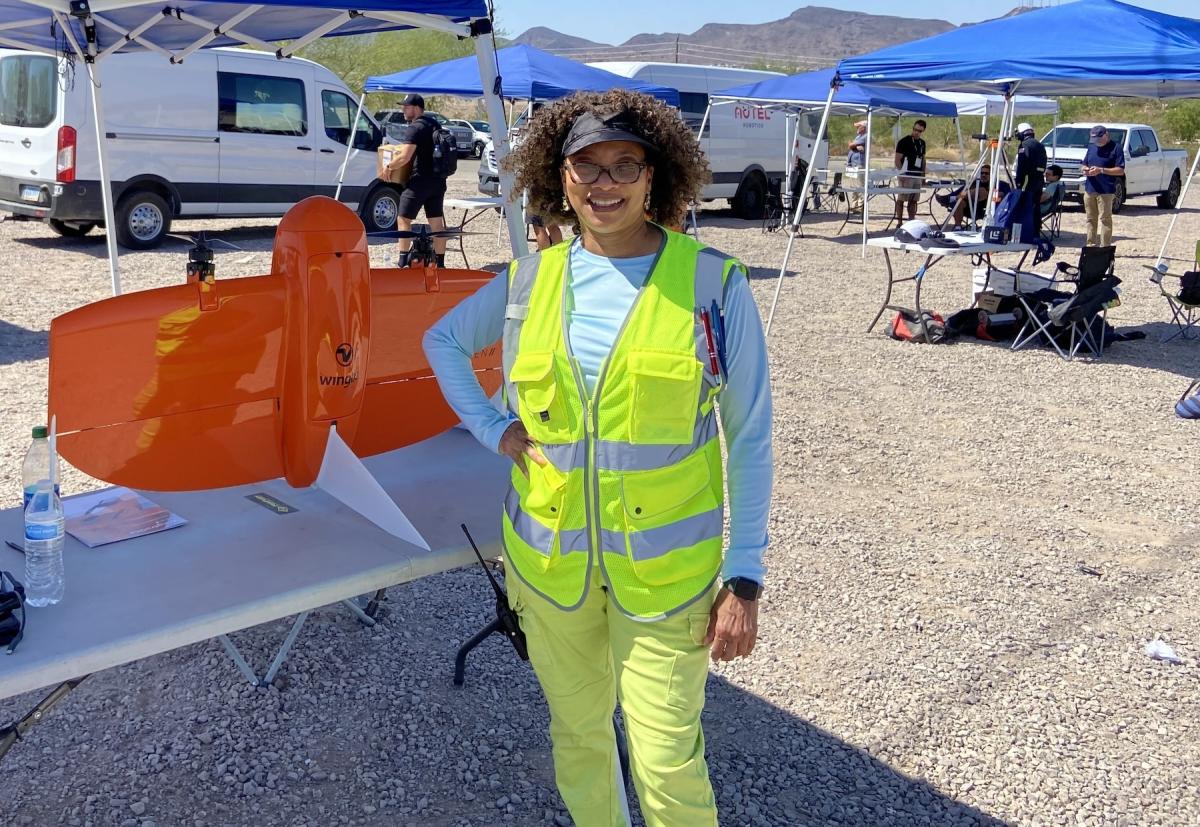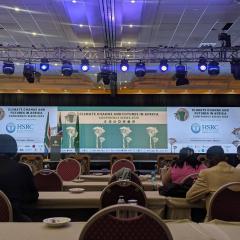
The “We” in WeRobotics: Experiencing Liberation in the Workplace
July 22nd, 2024

By Renee Welch, Ph.D, Co-Pilot
My first year has been an incredible journey for me as part of the WeRobotics team. Immersing myself in the WeRobotics way of working and being has been nothing short of revolutionary. Alongside a team of voracious learners, every day has felt like a masterclass in the art of continuous learning. Despite the full career that I had behind me when I joined the team as Co-pilot, they have taught me so much that I didn't even know was possible within the bounds of organizational culture. So much of what I have experienced as part of this team is stuff I had heard about but didn't know it could be.
In my role I have also discovered that I’m not the only one who finds the WeRobotics work culture transformative. Other organizations are starting to ask what the secret sauce is; how does WeRobotics do what it does? As I reflected on how we do things, I realized that what sets us apart is how freeing it feels to be a part of this team. I had been looking for a word to describe it, and I found it: liberating.
In a world where every-person-for-themselves is the norm, WeRobotics stands out as a workplace where care and authenticity are not just talked about but lived out. What makes our work culture truly inspiring is that it feels like genuine community in action. These days, the word “community” can often sound like just another buzzword, but I have found that it makes up the very fabric of our team. It forms the foundation of our entire workplace, creating an environment where you are free to truly be yourself.
The concept of a liberated organization is not a not a new one. That more and more companies and organizations are taking the leap to reimagine the workplace provides proof that this way of being and working is not only possible but also practical. As with most things, there are many ways to interpret and practice liberation: this is ours.
So how do I experience liberation in our workplace?
I can point to two core tenets of our work culture that position us as a workplace with a difference. The first is our holacracy-inspired approach to governance and the second is our self-identification as a learning organization.
Our Holacracy-inspired Approach
Holacracy was intriguing to me when I joined the WeRobotics team. Entering an organization that eschewed traditional hierarchies in favor of holacracy was a jarring yet invigorating experience. My previous work environments were characterized by clear lines of authority, rigid structures, and a top-down approach to management. In contrast, holacracy dismantles these conventions, replacing them with a decentralized governance model where roles, rather than individuals, hold authority. This means that power is not concentrated at the top but distributed across the organization, empowering every team member to take initiative and make decisions within their domains.
I will admit that initially, this felt strange, but it did not take very long before I began to appreciate the fluidity and dynamism that holacracy brings to the workplace, including:
- Deeper team engagement: In my previous roles, decision-making was often slow and bureaucratic, with multiple layers of approval required. In contrast, holacracy empowers individuals to act autonomously, leading to faster decision-making and faster innovation. It creates a sense of ownership and accountability among team members and as a result, they are more engaged and motivated because they know they have a direct impact on the organization's success.
- Enhanced collaboration: The collaborative nature of holacracy is one of its most significant strengths. Without the constraints of a rigid hierarchy, team members can collaborate more freely and effectively. This creates a culture of mutual respect and trust, where ideas are valued based on their merit rather than the position of the person proposing them. The result is a much more inclusive workplace where creativity thrives.
- Agility and adaptability: For most organizations (and people), the ability to adapt quickly is essential. Holacracy's flexible structure allows organizations to pivot and respond to new challenges and opportunities more effectively than traditional hierarchical models. In our team, we redefine roles and responsibilities as needed, enabling us to stay agile and resilient in the face of change.
- Clarity and transparency: Holacracy provides a clear framework for defining roles and responsibilities, reducing ambiguity and ensuring that everyone knows what is expected of them. This clarity extends to decision-making processes, which are transparent and well-documented. In my experience, this has led to a more accountable and cohesive team, where everyone understands their contributions and how they fit into our larger organizational goals.
Now, holacracy is not a perfect system, and it certainly isn't the ideal fit for every organization. Learning from other organizations' experiences with holacracy, WeRobotics decided to adopt a hybrid or “holacracy-inspired” approach better suited to our unique circumstances. This means we've built our own work environment that incorporates key principles of holacracy – such as circles, roles, and accountabilities – while adapting them to fit our needs and decentralized setup. We also created a space where the whole team came together to think through our ways of working, resulting in our holacracy constitution and organizational values, which serve as our team’s guiding light as we work towards our mission.
Although the absence of a traditional hierarchy may seem like a recipe for disorder, there is indeed a method to what initially appears to be madness. The key, I have learned, is learning to lead with trust rather than control. In a holacratic environment, you need to trust your colleagues and trust the process. And of course, this is why clarity and transparency are vital. One of the things I love most about our work culture is that everybody knows the strategy, everybody knows where we sit and where we stand. This openness and transparency is what allows us to trust that the collective wisdom of the team will prevail. And it is an empowering and liberating shift.
The learning curve I experienced is reflective of the environment of continuous learning and growth that WeRobotics offers to every team member. If we do nothing else, we are going to learn! Which brings us to the second thing that makes WeRobotics’ work culture unique.
WeRobotics as a Learning Organization
What does it mean for us at WeRobotics to be a learning organization?
It means that rather than stick to the plan no matter what, we are big on asking, “Is this working?” and being honest about the answer. It means being adaptable and flexible in the face of change, willingly adjusting structures and processes to suit the evolving needs of our organization and its environment – even though sometimes this feels like going backwards. It means that when we realize that something isn’t working, we retrace our steps, dropping ego and picking up learnings that become clear as we look back. Hindsight, after all, is 20/20. It means that in determining our next steps, we say “Let's try it. Let's see if it works. If it doesn't, we'll try something else.” Learning isn't a periodic event; it's our WOW, our way of working. And identifying as a learning organization is not just an approach; it's a philosophy, a way of life.
A big part of this is being appreciative of diversity. Just as with the global Flying Labs Network, diversity is one of our biggest strengths at WeRobotics. Our team of 11 is spread out across nine countries and five continents, and coming from such different cultures and having such varied life experiences, every member of our team brings something special to the table. We integrate this diversity into our work processes, carefully holding space for every voice and perspective and using our collective wisdom to make decisions. For instance, our inaugural book club reading was The Culture Map by Erin Meyer, and as a multicultural team we explored how cultural differences in matters such as communication, leadership, and decision making impact global business, and our team is stronger for it. By embracing diverse perspectives, we can tackle challenges more creatively and effectively, lifting each other up and becoming resources for each other. A great effect of this is that for us, risk and failure are not a crisis, just another opportunity to learn together.
Another practice that epitomizes our learning culture is our “pause and reflect” moments. These moments allow us to sit back and evaluate our work, celebrate our successes, identify areas for improvement, and learn valuable lessons. They give us permission to pivot if we need to – and we often do need to! In my view, reflective practice is crucial for both personal and organizational growth.
In a learning organization, there is a constant flow of new ideas and an emphasis on collective growth that can sometimes feel overwhelming. It’s a significant adjustment to shift from a mindset of top-down directives to one of mutual learning and growth – at least it was for me. Once again, trust is the bedrock upon which our collective growth is built. Trust that everyone is committed to the organization’s success, trust that feedback is given and received constructively, and trust that our shared knowledge will lead us to better solutions. Out-of-the-box thinking is necessary for any organization to truly thrive, and yes, this requires courage. But what we have learned is that with authenticity, care, and transparency, even daunting risks become exciting opportunities to learn and grow together.
A New Perspective
For me, that WeRobotics is a liberated organization – a human-centric, adaptive, and purpose-driven organization – shows up in our organizational values, our operational style, the essence of our work, and how we continually adapt our infrastructure in an ever-changing world to cultivate decentralization, collective learning, and clarity of purpose. It is evident in our holacracy-inspired governance, which meshes autonomy and collaboration in ways that bring forth the best of each individual as well as the best of the team. You see it in our emphasis on breaking down silos through resource sharing and open communication. It is why we lead with trust rather than a need for control.
Part of our work with the Flying Labs and our Inclusive Networks Model is carefully documenting our innumerable experiences, learnings, failures, and successes along the way and then sharing them in various formats to be a resource for other like-minded people and organizations. As we go through WeRobotics 4.0, this is a year of transformation for us, and we are leaning more into this work and into our identity as a learning organization by sharing the ways of being and working that power the engine of our organization. This way, we can all keep learning together.
The world is changing, and so is the workplace. For those who, like me, have spent their careers in traditionally structured organizations, the concept of liberation in the workplace may seem unfamiliar or even daunting. I share this journey to demonstrate that when we embrace a new way of thinking that goes beyond the traditional norms, we can collectively create cultures, even in the professional world, where individuals can be their authentic selves and contribute to a community that goes above the ordinary.
Welcome to the world of soulful workplaces – where passion meets purpose, and people can be not just cogs in a machine but whole, human, and free.
Recent Articles

